PEAKE / ROSENKRANZ / ISRAEL / HAYES / VAN DEN DORPEL
| July 6, 2012 | Post In LEAP 15
1. EDDIE PEAKE
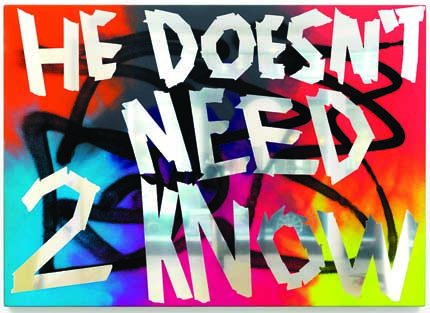
“Everyone just can’t stop talking about Eddie Peake!” was the slightly obnoxious maxim repeatedly uttered around London this past March. Indeed, the young artist’s work was featured in multiple well-known galleries in the British capital, some only blocks away from each other. In March alone, Peake launched a solo exhibition at Cell Project Space in Hackney, and was included in group shows at Jonathan Viner and Sadie Coles HQ, both in Mayfair. Peake seems to have an uncanny precocity for combining all things hip into one huge, heterogeneous, bumbling, sexually frustrated artistic practice. Ranging from sculpture to collage, video, and performance, Peake’s most notable efforts may be in his mirror works, placing detritus in a smiley-face formation over its reflective surface, which is then sprayed over with queasily jubilant neon paint. Other neon mirror pieces feature phrases like “HE DOESN’T NEED 2 KNOW” and “HETRO BOYS.” Also non-ambiguously homoerotic but supposedly heterosexual are his performances bringing together the oft-nude bodies of romantically beautiful young men in various banal choreographies.
While April 2012 saw Peake mount “Ruby,” a group exhibition of his own creation at Gallery Vela in London, the coming months will see him participate in exhibitions at the venerated Chisenhale, as well as within the Tate Modern’s “Oil Tanks” series. A 2006 graduate of the Slade School of Art in London, he is currently studying within the postgraduate program at the Royal Academy in London.
2. PAMELA ROSENKRANZ
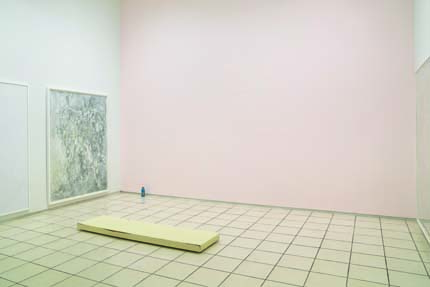
It’s difficult to ascertain what’s going on in Pamela Rosenkranz’s mind. Walking into an exhibition of her painting and sculpture— if they can be termed that— finds a wall painted a solid, pale pink, a few Gatorades cast about the wall, white monochromes, and clear, human-sized, self-standing bubbly Plexi sheets acting as room-dividers. At first glance, Rosenkranz’s work appears curiously vacant, and strangely commercial. Metallic cooling blankets are hung on the wall with the imprint of a clothed, female body (an obvious response to Yves Klein’s 1960 stunt, Anthropométries, in which he used the nude female body as a paintbrush), while bottles of water, such as Fiji or Evian, are filled with various human-colored silicones. Here, the medium is the message: Rosenkranz so aptly adopts the language of art history— the monochrome, inkblot-like imprint, synecdoche by skin color, etc.— and translates it to increasingly commercial fare, such that her overall oeuvre suggests that today, the role of the artists is just as much that of merchant as it is creator or innovator. Her aforementioned deceptively vacant pale pink wall is actually a commonly purchased shade of white produced by Ralph Lauren mixed with the soft drink, Gatorade— itself a metaphor for the “metabolic currency” or energy required of the artist to produce artwork, or of the viewer to comprehend it.
Rosenkranz studied at Academy of Fine Arts, Bern, Switzerland; Department of Comparative Literature, University of Zurich, Switzerland; and the Rijksakademie, Amsterdam. She recently launched a two-person exhibition at the Swiss Institute in New York with Nikolas Gambaroff, and a solo exhibition at Miguel Abreu, also in Manhattan, where she is represented.
3. ALEX ISRAEL
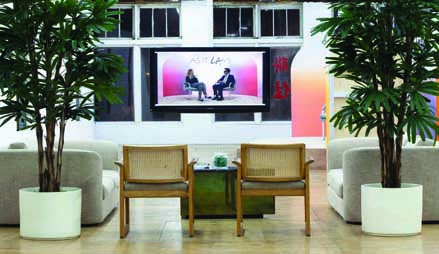
Alex Israel is completely and unrepentantly the epitome of a Los Angeles-based artist. Born and bred around Hollywood, Israel has made the strange props, set designs, and vacant sex appeal indicative of Los Angeles part and parcel of his artistic practice. For his recent exhibition at New York’s Reena Spaulings, Israel debuted his project “As it LAys,” a series of thirty interview-portraits with LA notables ranging from coif expert Vidal Sassoon and hilariously endearing, near-senile 95-year-old actress Phyllis Diller to the über-serious actor and restaurateur Michael Chow. Interview questions, delivered by the dead-pan, sunglasses-and-suit-clad Israel against a cheesy 1980s talk show backdrop, could be as philosophical as “What is the key to balancing confidence and humility?” or as lighthearted as “Chocolate or vanilla?” Surprisingly, Israel usually garners genuine responses. A blur of the serious and strange comes from Michael Chow: When asked “Who makes the best milkshake?” he responds, “I really don’t know, but sometimes I have a milkshake at Johnny Rocket’s… Milkshake, like everything else, is a dish created. So milkshake is unlike coffee, unlike orange juice, unlike other drinks, usually made out of ice cream. Traditionally, it has its structure, its intent of the author in this case, whoever created the milkshake. Everything has focus, everything has qiaomen. Qiaomen is a Chinese word which encompasses all secrets, all techniques, all know-how, all tricks, and more than that. So it’s a very good word. So when I say ‘milkshake,’ it has a focus for the milkshake…it encompasses all that stuff.”
Alex Israel studied at Yale University, receiving a BA in 2003, and the University of Southern California’s Roski School of Fine Art, receiving his MFA in 2010. He was recently included in the exhibition “Greater LA,” curated by Joel Mesler, Benjamin Godsill, and Eleanor Cayre in Soho, New York; and recently launched solo exhibitions at Reena Spaulings, New York, and Perez Projects, Berlin, who both represent him. “As it LAys” traveled to LA MoCA in May 2012.
4. SHARON HAYES
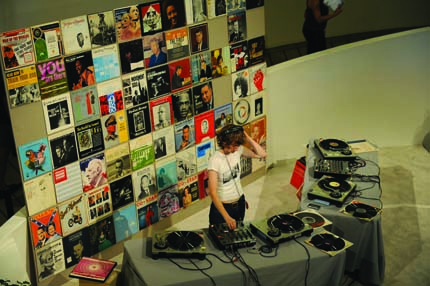
“There’s so much I want to say to you,” reads the title of Sharon Hayes’ upcoming solo exhibition at New York’s Whitney Museum of American Art. This statement aptly strikes at the core of Hayes’ work: having artistically matured amidst the gender-queer music and theater community in early-1990s New York, Hayes is defined by her interest in the speech act— its ability to shape and whittle our identities, its proclivity to mold our collective consciousness, and its tendency to fade from public memory. A recent exhibition at the Guggenheim found Hayes DJing records in the museum’s famous rotunda at the bottom of the Frank Lloyd Wright-designed building, surrounded by gaggles of museum-goers. Hayes sampled spoken-word records ranging from manuals on teaching your pet bird to talk to recorded Martin Luther King, Jr. speeches. The samples ranged from the outmoded to the nostalgic and the uncannily familiar. Though the Whitney accounts for one of her first solo museum exhibitions in the United States (her very first was in November 2011 at the Art Institute of Chicago), Hayes is no stranger to canonizing institutional exhibitions abroad. Notable shows include the Danish Pavilion for the 54th Venice Biennale, 2011; “Found in Translation,” at the Guggenheim, New York; “Mixed Use: Manhattan,” organized by Lynne Cooke and Douglas Crimp for the Reina Sofia, Madrid, in 2010; the 2010 Whitney Biennial, curated by Francesco Bonami and Gary Carrion-Murayari; and the most recent Greater New York, curated by Klaus Biesenbach for PS1 Contemporary Art Center.
Hayes received her MFA from the interdisciplinary studio department of the University of California, Los Angeles, and graduated from the Whitney Independent Studio Program in 2000. Represented by Tanya Leighton in Berlin, she currently teaches at the Cooper Union for Advancement in Science and Art in New York City.
5. HARM VAN DEN DORPEL
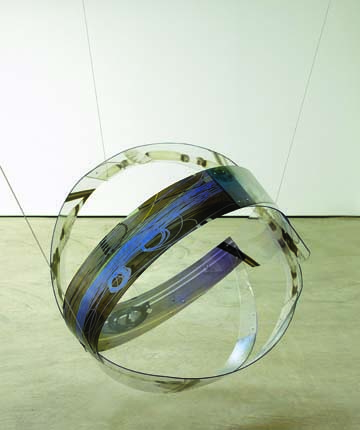
A Dutch artist living in Berlin, Harm van den Dorpel first became known in internet-related art communities for his initiation of the popular online gallery “Club Internet.” Running from 2008-2009, Club Internet provided an early opportunity for emerging artists around the world to share images of their own or others’ creations. Fast forward to 2012, and while we find online galleries and surf clubs supplanted by the likes of Tumblr and Instagram, previously web-based artists such as van den Dorpel have integrated themselves into a more object-based contemporary art world, showing in galleries throughout the world. Notably, van den Dorpel recently launched a solo exhibition in the London gallery Wilkinson, itself known for nurturing the career of legendary American artist Joan Jonas. Van den Dorpel’s March 2012 exhibition, furtively titled “About,” features round, sphere-like sculptures of bent Perspex hung from small ball chains, suspended from the gallery ceiling. Images of objects recalling systems of interconnectivity— such as chains, the weaving of fabrics, and so on— are printed upon the translucent Perspex. Complementing the sculptures are collages heavily layered with found imagery, its sources including DeviantArt, the popular alternative social networking site for young artists. Van den Dorpel also curated the venerated exhibition “Rhododendron,” which first launched at W139 in Amsterdam in 2010 and subsequently traveled to SPACE, London, in 2011. Previous exhibitions include “Free” (2010) at the New Museum of Contemporary Art, New York; “Collect the World” at Link Art Centre, Brescia, Italy; and “New Wave” at the Internet Pavilion within the Venice Biennale, 2009. Van den Dorpel studied at Gerrit Rietveld Academie and Vrije Universiteit, both in Amsterdam.


